Words & photos by Drew Petersen
I lend a hand to take our duffel bags and skis off the roof of the UAZ, a Soviet-era van that reeked of diesel on our ride here. We hand the luggage off to local porters. Smiles and thumbs-up prove to be our best form of communication as they strap our gear to the sides of their horses. I kick the heel of my ski boot against the dry dirt and slide the buckles over to the correct settings. It feels as though this simple act is finally the affirmation that we are indeed here to ski. I’m over 6,500 miles away from home, in the United States, making the last place where I put ski boots on my feet, quite literally, halfway across the world. Now, we are in Kyrgyzstan, a Central Asian nation that is slightly smaller than the state of Nebraska, but with a nearly opposite landscape: The country is 94% mountainous.
Watch Now: The Shadow Campaign Volume IV, Song for the Nomad.
Five years ago, one of the members in our crew, Stephan Drake (the founder of DPS Skis), traveled to this same Issyk Kul region of the country in the summer, visiting his girlfriend’s family; she grew up in the capital city of Bishkek. After seeing the beauty of the mountains and the skiing potential they may hold, he knew he would have to return in the wintertime. And so, here we are. The rest of the crew consists of American cinematographers Ben Sturgulewski and George Knowles; Piers Solomon, a skier from Engelberg, Switzerland who wields three different passports—he is using his Swiss passport for this trip; and lastly, myself, an American skier. Stephan, 40, has a résumé of ski travel destinations that would make anyone jealous: Argentina, Alaska, the entirety of the Alps… the list is truly endless. Despite this, he always seems to me to be one step behind in his trip preparation, figuring things out as he goes. But this is just the style he’s accustomed to for these global exploits. He makes last-minute adjustments to a pair of brand-new prototype skis that he hadn’t even tested before bringing to Kyrgyzstan, then hands off the last of his gear to the porters.
A shepherd passes by on the street with a flock of sheep. The horses and porters follow suit, upwards to the mountains. Skis in hand, we walk up the dirt road until there is enough snow to ski. I put my boards down, narrowly missing a pile of what the horses had left behind on our “skin track,” click in and begin to ascend into the Mountains of the Heaven—the Chinese meaning of the range’s namesake, Tian Shan.


Along the path of the Silk Road, the Osh Bazaar in Bishkek, Kyrgyzstan offered a challenge of its own to navigate and determine just what that food might be.


Manas, an ancient war hero, keeps watch over the country. In the center of the Kyrgyz flag lie symbols representing yurts and the 40 nomadic tribes that used to roam these lands and make the mountains their home.
The cold, dry air filling my lungs felt as pure as I imagine air can possibly be. I was following Ptor Spricenieks, the lead guide at 40 Tribes, the skiing outfit and yurt camp that we are currently calling home. Ptor, a Canadian ex-pat now living in La Grave, France, is a mythical legend of sorts in the ski world and a name all skiers should know, yet few do. He seems right at home based out of a yurt, enjoying life off the grid. He is utilizing a one-of-a-kind pair of skis that he designed himself; dubbed the Wolverine, he says the skis are ideal for the unique snowpack here. As we neared the top of the ridge on the last pitch, a glorious mountain emerged on the horizon. The peak grew with each step, revealing more of the rock, ice and snow forming its formidable but alluring north face.
“Wow, I didn’t know you guys had a Grand Teton here,” I couldn’t help but remark.
“What?! I thought that was the Matterhorn,” Ptor quipped back to me, accompanied by a flashy grin over his shoulder.
Rather than five dice, Stephan only needs to win a game of rock-paper-scissors and he is up first to ski the Yahtzee Couloir. He drops in. His skis—a slightly modified DPS Spoon, similar to, but perhaps more refined than Ptor’s Wolverine—plane out, and he arcs back and forth. A rib of rock on the skier’s right acts as a boundary of sorts, indicating when he should drop back in to the left. He utilizes the double fall line to simultaneously release and generate speed with every turn. Piers follows suit, gliding with speed down Easy Rider, a glorious ramp just to the south that continues for 3,000 feet.
I dropped in to Yahtzee. Each run is a learning process for this snowpack. As a result of the high altitude and consistently cold temperatures, not to mention great distance to any ocean, the snowpack is best described as a meter of facets. I keep in mind the advice Ptor gave me: “Speed is your friend. Without speed, you will literally sink to the bottom.” My movements are light, easy and most of all, patient. I initiate each turn ever so slowly, subtly, then simply surf it through to completion, rather than forcing the radius, hacking or slashing. It’s different. It’s fun.
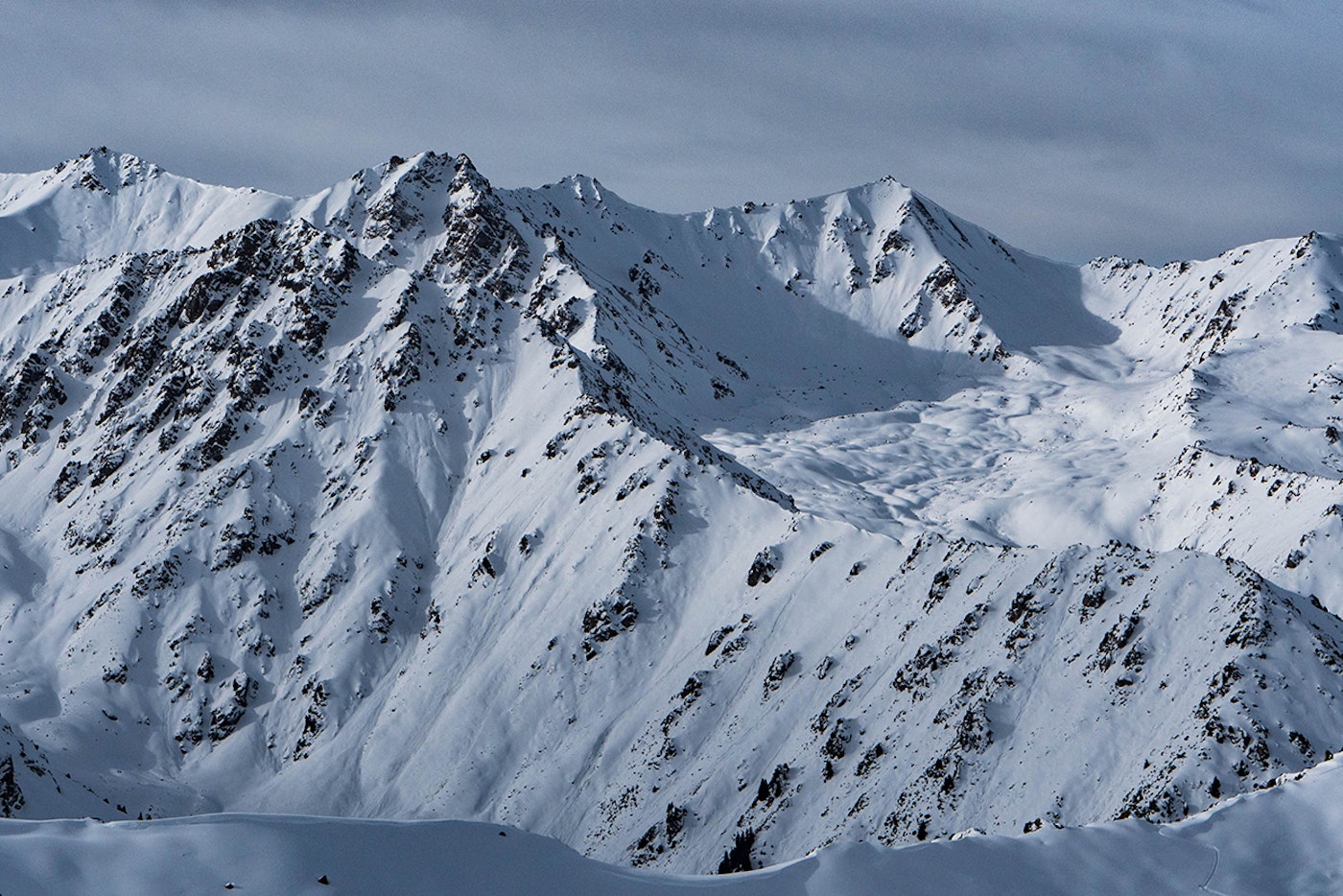



Piers Solomon (R) and Stephan Drake (L) make the last push up to the ridgeline to some of the best lines of the trip.


Surfing each turn and embracing the dry, continental snowpack, Piers whisks his way down another line, deep in the Kyrgyzstan backcountry.
The yurts have already proven to be a practical form of lodging, here. A centralized fire burns warm, drying our gear each night. There is enough room inside to take off your boots, sleep comfortably, and, well, not much more. The good thing is, we don’t need anything more for this way of life. Historically, Kyrgyzstan was a land of nomads and yurt-like structures were home to many, in valleys just like this and heck, probably this valley, too. Horses were used to transport families’ belongings (including the yurts) to support the nomadic lifestyle, dictated by harvests and strategic threats. Tomorrow we would again strap our duffels to the horses to transport out of here and travel to another valley.
It’s hard to think that less than a week ago, we were wandering the busy, loud streets of Bishkek, the nation’s capital—a city full of concrete block architecture left over from the Soviet Union’s rule of the region, which ended in 1991. In the rural areas, economic struggles are forcing an increasing number of young people to move either to Bishkek or out of the country, mostly to Moscow, data shows, to find work to support their families. This is threatening the Kyrgyz way of life and the historical culture in the area, which still centers around the mountains.
The blue light of the full moon glimmers off the snow around the yurts, adding to the stillness and serenity of this paradise. I sip on a bottle of Kyrgyz vodka as a nightcap, a cheers to life itself, to this beautiful country, and to the simple, traditional way of life.
Piers traces the topographic lines with his finger. The map is rudimentary in nature, drawn with marker on a spare piece of plywood, but it proves to be helpful. We look up to compare the lines with the horizon above, trying to get our bearings in our new home—a Russian yurt camp in the Aksuu Valley. While only two valleys to the west of the 40 Tribes yurt camp, this feels extra foreign. Vincent and Anthony, two French Canadians whom we have just met, come over. Vincent speaks up in broken English, “Today, just take dees ridge. Eet’s where you can see ebberyting. Ant-ony and I put in zee boot pack last week.”
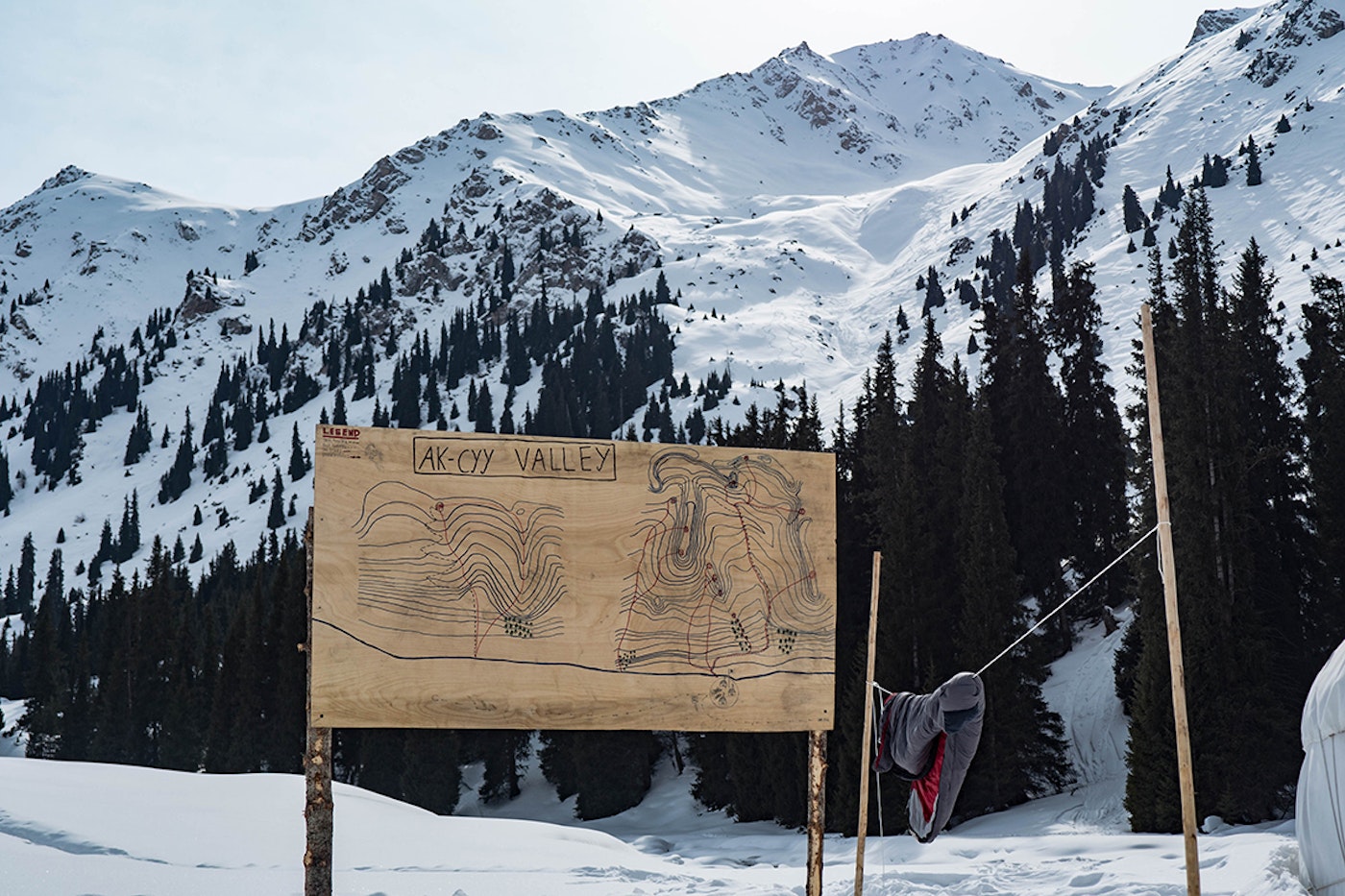
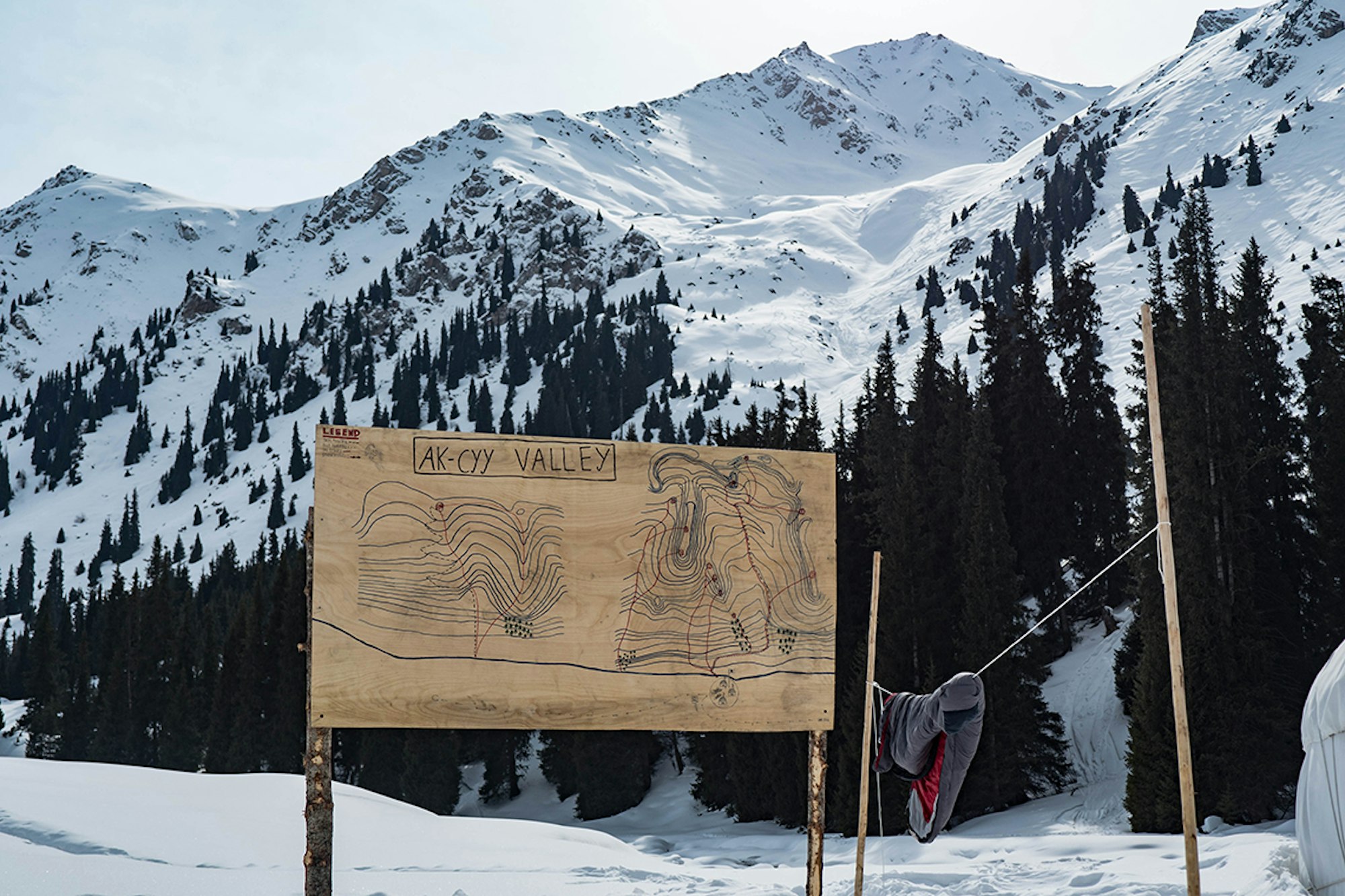
Atop the ridge, Piers and I both start to fantasize over the new lines on offer: long, wide ramps that empty into the valley to the west. When we first arrived in Kyrgyzstan, Piers, perhaps out of his own national pride, was skeptical of a sign in the Bishkek airport which read “Kyrgyzstan: The Switzerland of Central Asia.” But now, he seems a little more convinced of the moniker. Milky skies and the end of the day are fast approaching, so we won’t ski them today. Before long, we are enveloped in the clouds and it begins snowing for the first time since we arrived in the country nearly two weeks prior. The French Canadians lead us to the entrance of a couloir that drops back to the east, towards our camp, below. We take turns, making our way down from one safe zone to the next. The turns are fun, reminiscent of the skiing at 40 Tribes, but even more hollow and admittedly sketchier. The faceted snowpack flushes into rivers of slough, propagating increasingly farther down with every ski cut we make in the couloir.
At dinner, Vincent and Anthony share that we are lucky we hadn’t been here two weeks earlier. It was negative 40 degrees every night. Celsius or Fahrenheit does not matter in this instance; 40-below is the temperature at which the Fahrenheit and Celsius scales correspond with one another. For us, it had been balmy in comparison. That night I made a run to the outhouse, sporting nothing but boxers, a puffy coat and a rabbit skin hat I bought in Bishkek. The sky was full of stars.
Back in the yurt, before drifting off to sleep, I imagined the individuals who had roamed these valleys generations earlier. And I thought of those who might dwell here in the years ahead. The history of the nation is rife with change, from being conquered by the Mongolian empire to more recently being positioned on the outer edge of the Soviet Union. The future holds challenges, as world superpowers once again are looking to spread their tactical hegemony into Central Asia because of interests in oil and natural resources. But, perhaps being the Switzerland of Central Asia is just enough of a strategic answer to get by in the global landscape, for now. But, there are issues at home, too. The issue of urbanization is impacting the families and culture down valley from places like Bishkek. Whatever happens in the next 10, 20, 30 years, these mountains will always be the wild homeland of the Kyrgyz people.


The spoils of yurt life in the Aksuu valley were lush and abundant: a Russian swing, wood-fired hot tub, sauna, warm sleeping quarters and a river with fresh, cold water to wash off at the end of the day.
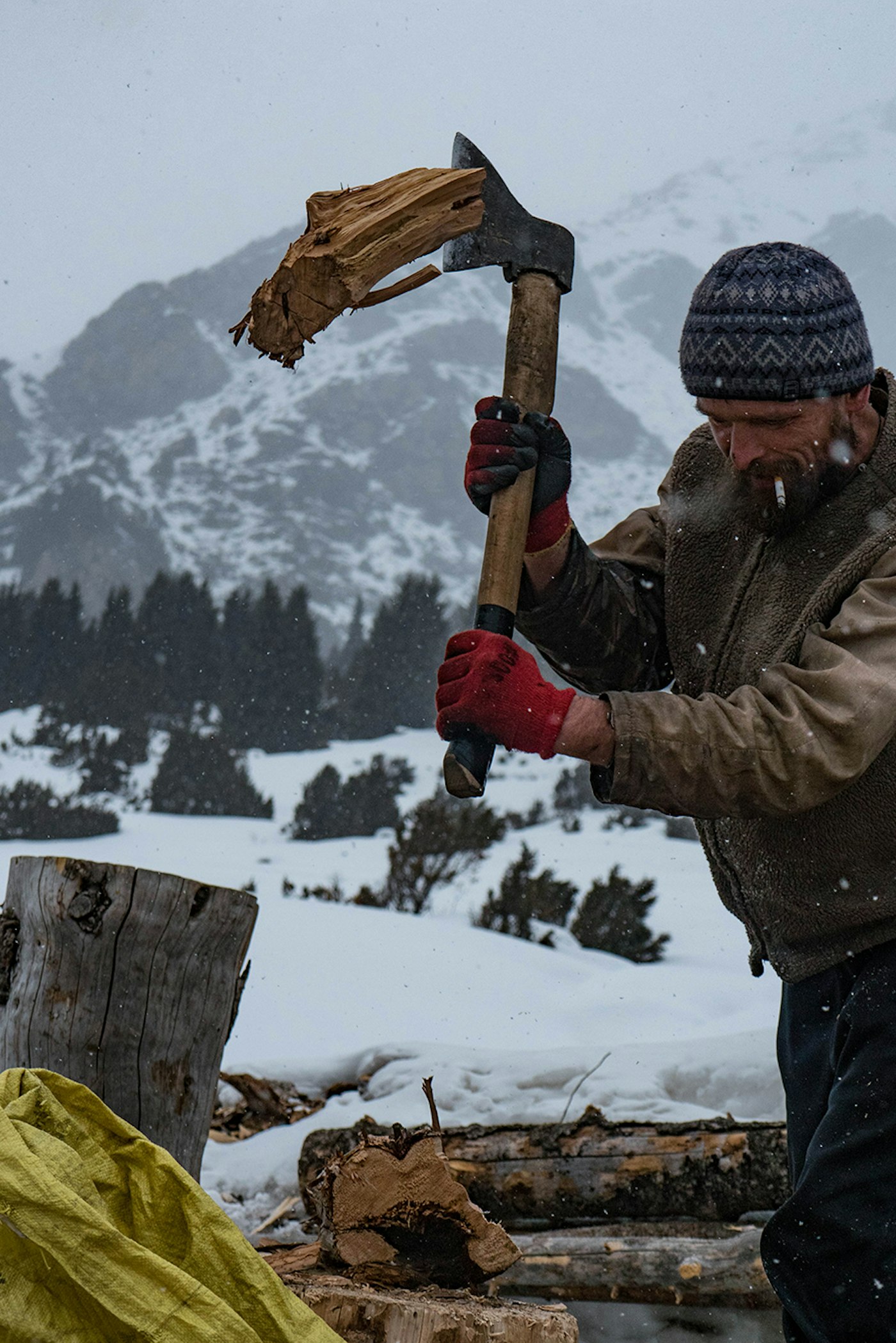

Slava, a man with a kind soul and a smile that wiped away the language barrier. Not pictured are the sandals he would always run around in.
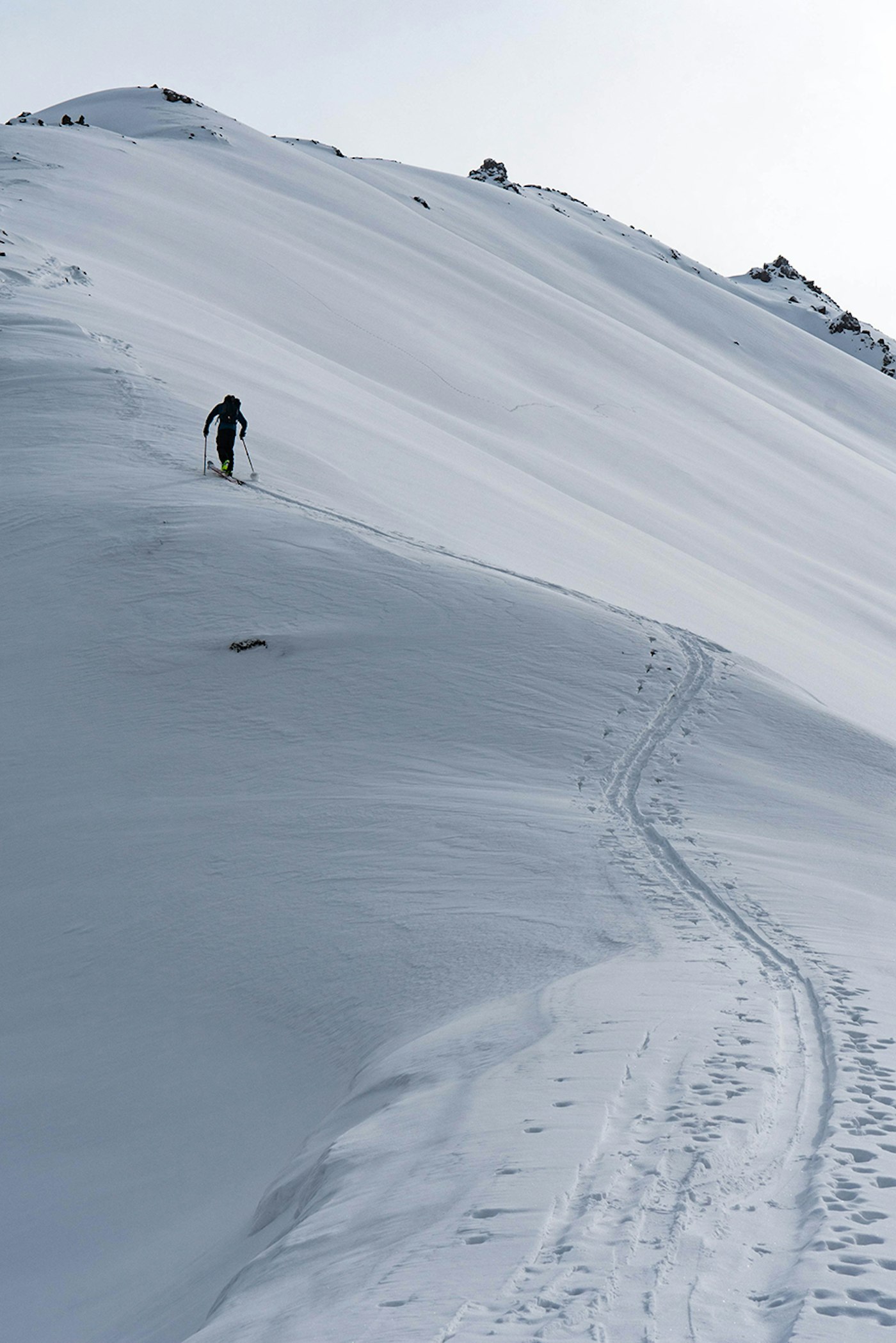

Piers Solomon on the way up. The lines that dropped off this ridge were exactly what we came all this way to ski.
My headlamp and the moon above served as sufficient guides as we made our way upwards, once again. It was the morning of our last day on skis in Kyrgyzstan and the crew was getting an early start to make the most of it. We ripped skins at the perfect time. A golden glow was enveloping the eastern skyline. “Montagne, alatoe,” I said to myself, a small piece of Kyrgyz I had purposefully picked up for moments like this. “Good morning, mountains.” I skied first, relishing the small slope we had positioned ourselves on. Piers dropped next, flashing through the morning light, a trail of glimmering facets sprayed like diamonds in his wake.


Later that afternoon, atop a ridge, the dreamy ramps we scouted on the first day in the Aksuu came back into view. As I glanced down at the potential skiing zones, an eagle appeared with what must have been an eight-foot wingspan, as big as any I’ve ever seen. It rode a thermal upwards before banking north and soaring down the valley. We continued south, up the ridgeline, and deeper into this land of wonder. Stephan and Piers prepped to drop in on the first two lines and I continued farther.
Soon, tracks that clearly belonged to a cat, likely a snow leopard, guided my way. The snow leopard, whose population in the entirety of Kyrgyzstan is estimated to be in the range of 150-500, is likely the most sought-after, yet most elusive, animal in these mountains—and perhaps any mountains, anywhere in the world. The tracks led straight to the top of my line, providing yet another fresh perspective on the Tian Shan. Countless lines and ramps were abounding and new peaks emerged on the horizon.
I clicked into my skis and looked to the other side of the valley where the sun was now feathering the ridgeline. Soon it would set over all of Kyrgyzstan and work its way west, along the course of the ancient Silk Road, and eventually across the Atlantic Ocean, to home. I pushed off. My skis picked up speed, the wind whisked across my face and I was propelled into the last light of the day.

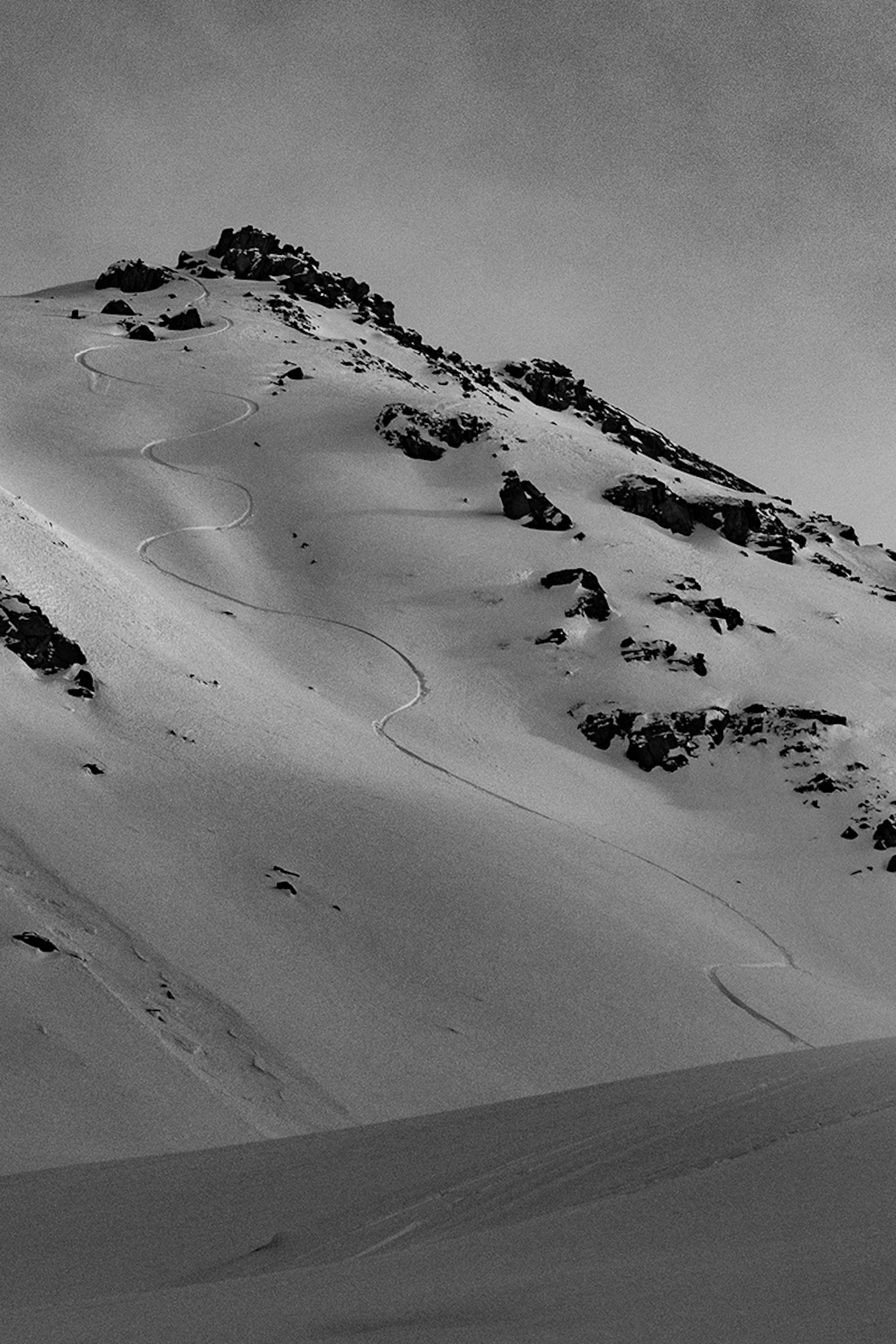
To climb to the top of this line, I followed snow leopard tracks. Naturally, I left some tracks of my own. — Drew




![[GIVEAWAY] Win a Head-to-Toe Ski Setup from IFSA](https://www.datocms-assets.com/163516/1765920344-ifsa.jpg?w=200&h=200&fit=crop)

![[GIVEAWAY] Win a Legendary Ski Trip with Icelantic's Road to the Rocks](https://www.datocms-assets.com/163516/1765233064-r2r26_freeskier_leaderboard1.jpg?auto=format&w=400&h=300&fit=crop&crop=faces,entropy)





![[GIVEAWAY] Win a Head-to-Toe Ski Setup from IFSA](https://www.datocms-assets.com/163516/1765920344-ifsa.jpg?auto=format&w=400&h=300&fit=crop&crop=faces,entropy)

